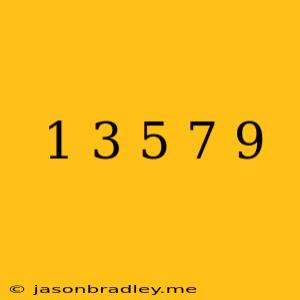The Curious Case of 1, 3, 5, 7, 9
The sequence 1, 3, 5, 7, 9… is a simple one, yet it holds a fascinating position in the world of mathematics. This sequence, known as odd numbers, is fundamental to understanding the properties of numbers and has applications in various fields.
What Makes Them Odd?
The term "odd" refers to numbers that are not divisible by 2. In other words, they leave a remainder of 1 when divided by 2. This simple definition leads to a wealth of interesting properties:
- Sum of consecutive odd numbers: The sum of consecutive odd numbers always results in a perfect square. For example, 1 + 3 = 4 (2²), 1 + 3 + 5 = 9 (3²), and so on.
- Alternating sum: The alternating sum of consecutive odd numbers always results in zero. For example, 1 - 3 + 5 - 7 + 9 = 0.
- Arithmetic progression: Odd numbers form an arithmetic progression with a common difference of 2. This means each number in the sequence is 2 more than the previous one.
Applications and Significance
Beyond their mathematical properties, odd numbers have significance in various areas:
- Number theory: Understanding odd numbers is crucial for exploring concepts like prime numbers, factorization, and modular arithmetic.
- Computer science: Odd numbers play a role in algorithms, data structures, and cryptography.
- Physics: Quantum mechanics utilizes odd numbers in describing the properties of particles.
- Music: The concept of odd and even intervals is important in understanding musical scales and harmonies.
The Beauty of Simplicity
While the sequence 1, 3, 5, 7, 9… may appear simple at first glance, it harbors a rich tapestry of mathematical properties and applications. Its study provides insights into fundamental concepts in mathematics and helps us appreciate the beauty of seemingly straightforward patterns.
